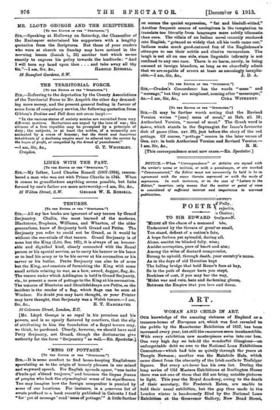A RT.
WOMAN AND CHILD IN ART.
OUR knowledge of the amazing richness of England as a, treasure-house of European art, which was first revealed to the public by the Manchester Exhibition of 1857, has been increased every year, but still the resources seem inexhaustible. With every exhibition new masterpieces swim into our ken. One very high day we beheld the wonderful Giorgione—an unforgettable debt we owe to the National Loan Exhibitions; Committee—which had lain so quietly through the years at Temple Newsam ; another was the Malahide Hals, which; came direct from the obscurity of the Irish castle to Trafalgar Square. But every art-lover has his own list.. During the long series of Old Masters Exhibitions at Burlington House there was not one of them that did not bring notableTictures to light. This year the Royal Academy, owing to the death of their secretary, Sir Frederick Eaton, are unable to hold their usual exhibition, but the gap thus made in the London winter is handsomely filled by the National Loan Exhibition at the Grosvenor Gallery, New Bond Street, which is indeed one of the most remarkable collections ever brought together for temporary exhibition. A considerable number of the pictures are being shown for the first time, a triumph which all organizers of such shows keenly desire. Mr. Francis Howard, the secretary, and the committee must have worked bard for the success they have achieved. The pleasure one derives from these exhibitions, however, is not unalloyed, for it is common experience that the best of the pictures are not visitors up in London for a season, but emigrants passing through London on their way abroad. Rumour has already been busy with several of the works at the Grosvenor, but the one considerable art treasure that has recently passed into the custody of art dealers' from the family which brought it to England in the eighteenth century is not here. That is the smaller Raphael, "Madonna and Child," from ransha.nger, which Lady Desborough has sold for 070,000, a figure which made it impossible for the 'Trustees of the National Gallery to consider it when they were given an option in the matter.
The other Pansha,nger Raphael, however, is here. It is in fine condition, and its beautiful design and colour, despite its strongly mannered convention, place it among the best of Raphaers early works. Facing it is a picture which we can enjoy without after-thought of bail and farewell. This is the very late Titian "Madonna and Child," which Dr. Richter captured for the late Dr. Mond, by whose generosity it will ultimately pass, with many other fine things, to the nation. It is Titian in his very late manner, but on this small scale it is the knowledge, not the weakness, of age that impresses us. Sir George Holford's " Lucretia," by Lorenzo Lotto, Mr. R. H. Benson's "Portrait of a Lady," by Bernardino Luini, Mr. Hugh Morrison's fine "Portrait of a Lady," by Bernardino de Conti, the Duke of Wellington's "A Nun" by Rubens (not previously exhibited), and Lord Spencer's "A Daughter of Gerbier " by Rubens, that haunting Cranach "Melancholia," lent by Lord Crawford, and a very interesting Venetian work, "Tobias and the Angel," which some writers believe to he a Titian, are among the most notable foreign works. The English section is rich in rare and charming things. Most interesting of these is the equestrian portrait of "Henry Prince of Wales," by Isaac Oliver, the eminent seventeenth-century miniature painter. Mr. Lionel Cast has almost proved Oliver to be English-born, although of French parentage. This highly wrought work proclaims the miniaturist, but the controlling lines of the design are large and noble, and Oliver now steps into a new place in our art history. The picture has lain for an unknown time at St. Donate Castle, in Wales, and is now exhibited for the first time by the kindness of Mr. Godfrey Williams. The splendid collection of Gainshoroughs, Reynoldses, Hogarths, Raeburns, and Lawrences cry out for a panegyric on the English school, but my space only permits me to indicate that they are



































































 Previous page
Previous page